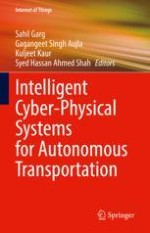2022 | OriginalPaper | Chapter
2. Future Autonomous Transportation: Challenges and Prospective Dimensions
Authors : Muhammad Waseem Akhtar, Syed Ali Hassan
Published in: Intelligent Cyber-Physical Systems for Autonomous Transportation
Publisher: Springer International Publishing
Activate our intelligent search to find suitable subject content or patents.
Select sections of text to find matching patents with Artificial Intelligence. powered by
Select sections of text to find additional relevant content using AI-assisted search. powered by
